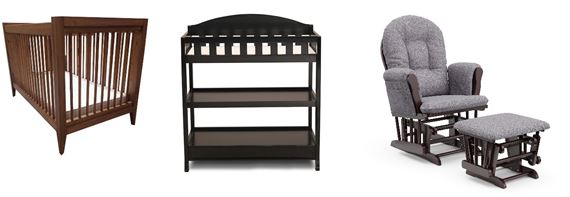Pregnancy comes with a lot of questions in general and what is safe to eat or what to avoid is probably not high on the immediate list. You are growing a human, your emotions are all over the place, you might not be sleeping great and you may experience aversions and cravings. YES, your nutrition is important too as it is helping with your baby’s growth and development while in utero.
Eating for two doesn’t mean you should DOUBLE everything that you are eating. Most health care professionals recommend an additional 200-300 calories per day during pregnancy but that could vary based on your weight going into pregnancy. Consult with your doctor, midwife or dietitian to know specifically what you should aim for.
The American College of Obstetrics and Gynecology (ACOG) recommends moms eat a balanced diet of extra calcium, folic acid, iron and protein. Calcium is important for building baby’s bones and teeth (ex milk, yogurt, cheese, kale). Folic acid is important to prevent birth defects in the baby’s brain or spinal cord, also known as neural tube defects (ex, leafy greens, fortified cereals, beans, pasta, bread). Iron is needed to increase mom’s blood to supply to baby’s oxygen (ex. meats, fish, poultry, dried beans). Protein is super vital for baby’s brain and heart development (meat, poultry, eggs, nuts, tofu). https://www.acog.org/patient-resources/faqs/pregnancy/nutrition-during-pregnancy
Good pregnancy nutrition is one of the BEST first gifts we can give to our baby.
Colleen Laszakovits, RN, postpartum specialist at Your Family’s Journey (www.yourfamilysjourney.com) spoke with dietitian Sarah Duke about what is safe and what to avoid during pregnancy. Sarah is a Registered Dietitian Nutritionist, Certified L.E.A.P. Therapist and co-founder of Duke Nutrition Experts here in Tucson (https://www.dukenutritionexperts.com/). She helped me break down the list of what is SAFE to eat and what to AVOID while eating during pregnancy. Keep this information handy.
Q. Sarah, we know water is the best beverage to be consuming during pregnancy, how much of it should I be drinking daily? Any suggestions besides adding lemon, cucumbers or fruits to enhance its flavor? Can I drink sparkling or seltzer flavored waters?
A.The amount of water you should drink varies from woman to woman, but a good rule of thumb is 8-10 cups of water per day. The good news is other fluids like milk, juice, tea, etc. all count towards your total. Sparkling and seltzer waters are great ways to change things up! I like adding a small amount of 100% fruit juice to seltzer water to add flavor and for a little fizz.
Q. Sometimes I need some caffeine in my life. How much coffee is ok throughout the day? What about an occasional soda? Should I look for caffeine free if I just enjoy the taste? What about diet sodas?
A. It’s best not to have caffeine during pregnancy because it increases your blood pressure and heart rate. However, pregnancy makes you tired and a little caffeine can really help! Some studies have shown no increased risk of miscarriage in women who drank a minimal amount of caffeine daily (the studies are mixed on this.) If you chose to drink coffee, stick to 200 mg or less per day. That’s about 12 ounces of coffee.
Soda can be a hard habit to break, but if you have a hard time stopping, stick to one soda or less per day. Soda contains a lot of chemicals and sugar (or artificial sweetener if diet) that can be harmful. If you need the caffeine, opt for a cup of coffee or tea.
Q. My partner loves our sushi date night. What is safe for me to order when we are out?
A. The issue with raw sushi is that it may contain small parasites that can make you feel very ill and decrease nutrient absorption (because of unpleasant GI symptoms, aka vomiting and diarrhea). For this reason, it’s better to stick with sushi made from cooked fish, such as California rolls (made from imitation crab meat), shrimp rolls, unagi rolls (cooked eel), spicy crab roll, or vegetable rolls. Basically, if it’s cooked, it’s fine.
Q. I love sub sandwiches from anywhere. Do I really need to heat up my deli meat before I eat it?
A. While the chances of becoming infected with listeria from deli meat is low, pregnant women and their developing babies are more vulnerable to serious complications. On this one, I do recommend cooking deli meat or avoiding it during pregnancy. Most sub shops offer a grilled chicken or veggie option that is a safer bet.
Q. What is the current word on FISH, of all kinds? Are mercury levels still something we need to be concerned about?
A. We do need to pay attention to mercury, but most people don’t eat enough fish! Fish contains omega-3 fatty acids which are so important for pregnant moms and for the developing child. Aim to eat 8-12 ounces of fish weekly, but choose low-mercury types, such as salmon, tilapia, shrimp, tuna and cod. If you eat a lot of tuna, limit that to 6 oz per week since tuna is a high mercury fish.
Q. Pasteurized vs unpasteurized milk? I love all things dairy, especially cheeses. Which cheeses should I steer clear from?
A. Drinking unpasteurized milk is a popular trend, but in pregnancy, any milk that you drink needs to be pasteurized. Unpasteurized milk may contain listeria which is unsafe. The pasteurization process kills listeria. Cheese made with pasteurized milk is also fine! Avoid mold-ripened cheese such as brie, camembert, chevre (or other cheeses with a rind), blue cheese and gorgonzola.
Q. Our family makes our own ice cream and salad dressings but I know raw eggs can cause harm. What do I need to be aware of when making our own home made treats and dressings?
A. Raw eggs can be contaminated with salmonella so they are not recommended during pregnancy. However, you can use pasteurized eggs and those would be safe to eat raw. You can purchase pasteurized eggs in most grocery stores.
Q. 2-part question. 1) I used to love chicken & eggs but now I can’t stand either, any suggestions to get my protein in? 2) I am craving sweets more than usual, any suggestions for something to cure my sweet tooth without the additional sugar?
A. Aren’t cravings and aversions during pregnancy fun?! Luckily there are many ways to get in your protein without eating chicken and eggs. Beef, pork and fish are all high in protein, as well as many vegetarian sources such as beans, lentils, edamame, tofu, whole grains and even vegetables. And don’t forget dairy, such as milk, cheese and yogurt.
Smoothies and frozen fruits are great ways to take care of that sweet tooth during pregnancy without adding a lot of extra sugar and “empty calories.” I am sharing several recipes with you so you have some new ideas to try! Hopefully, something will look good and help you through the cravings!
Q. Lastly, do I need to scrub my fruits and veggies or can I just rinse them under water in the sink before I eat them?
A. Bacteria can be found on the skins, peelings and rinds of fruits. Rinse fruits and veggies under running water and use a vegetable brush to remove dirt. If an area is damage or bruised, cut it away as bacteria can grow in these places.
Thank you Sarah for this helpful and important information. Take your prenatal vitamin, think about what you eat, how it is prepared and stored to help minimize potential issues with you and your growing baby. The members of Gateway Tucson (https://gatewaytucson.com/our-team/) love to collaborate with each other to provide amazing services for our Tucson community. Gateway Tucson (www.gatewaytucson.com) is your one stop hub for all things pregnancy, postpartum and parenting. Feel free to cruise around our website to see how we can support your growing family.


